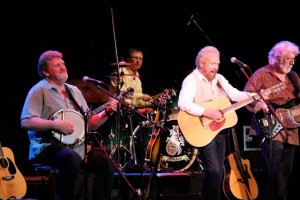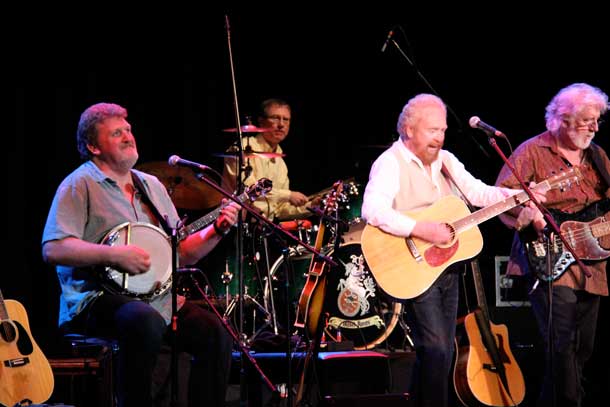
And so some years ago I hitched, walked and hiked across the face of Ireland on a quest to eventually get to Yeats’ mountain known as Ben Bulben in his Atlantic Ocean town of Sligo.
Yeats, of course, wrote those instructions to travel away from Dublin to a younger writer Who was John Millington (J.M.) Synge returning home to Ireland from Paris.
J. M. Synge would make his way West to the historic settings of some of the most historic Irish who still spoke Irish on the Aran Islands. The culmination of Synge’s meanderings being his work called: Playboy Of The Western World. The western world being the three islands of Aran well away from the cove of Galway. While J.M. Synge’s reference to playboy was an Irish term for a live actor. Really, “a play-boy”speaking his rehearsed lines in a theatrical drama while moving between the sets on a stage especially made for this kind of performance.
However as I was hiking the long stretch of country road, that sweeps like the curve a sickle, approaching Drumcliffe Churchyard –where Yeats now rests –the voice from an old sailor plus his question lifted in the air.
“Now, what would a Canadian be wanting to find in these parts?” he asked. It was obvious he’d spent time sailing other places. For he’d recognized a small maple leaf flag on my back pack.
“Well,” I began, “William Butler Yeats –your countryman–called this region his Irish home. We’ve long read his work in our college. Besides Yeats did eventually win a Nobel Peace Prize. And, it’s that measure in his life’s work that really calls me here.”
“Well,” he was responding, “you’ve chosen one of our finest. He saw many changes. Weathered stormy battles. Made sense of chaos. Because it has been said Ireland is the largest open air asylum in the world. But as an American said about Yeats, ‘mad Ireland hurt him into poetry.’ And you know coming from our remote west even the British have rather ‘lionized’ Yeats writing as he wrote much in the english vernacular.”
Proving, to me, that no matter where one goes in Ireland the locals know poetry. That was W.H. Auden whom he quoted who wrote a classic eulogy for W.B. when Yeats passed on in 1939. And, through the Ages, Irish men and women have shouldered and emerged through so much. The plague of a gut wrenching potato famine that drove generations to other places. Including Canada and the USA.
A reign of brutal colonialism that literally ran rampant beneath the deadly Black and Tans. Their Rebellion, of 1916, and the Easter Uprising. Culminating In their own flag and Republic of Independence.
After our casual introduction, we spent a fair bit of time walking the longer way to Drumcliffe. He passed on stories about the Seven Seas he’d seen. Spoke a fair bit about China, and, the Philippines besides the Land Down Under in both Australia and New Zealand.
But making it to Yeats site will forever remain dramatic. The spires of the church appearing at such a distance through a light fog like the points of a snail. The backdrop of Ben Bulben which is as flat and green as a billiard table. I’d brought along few lines by Yeats, in a college text, just as a few riders on horseback rode quietly by cherishing the leprechaun greenery in this setting.
Yeats wrote:
Cast a cold eye
On life, on death.
Horseman, pass by!
Yeats became the epitome of a literary genius seeing it all. While understanding, and, motivating the Irish as the 19th century became the 20th. Yeats was emphatically: simply creatively unique. Like no other before him.
Yeats quarried and refined Ireland’s frustrating fluctuations. Attempting to soothe what had gone before not only in his poems and speeches (for he was elected to a political office) but as well his part– along with Maude Gonne -in pioneering, resurrecting an Irish way of seeing themselves through the forceful script writing of its younger authors. Using realistic performances, with no punches held back, on the lively stages of the Abbey Theatre in Dublin. A cultural landmark that would carry a Yeatsian mark of substantial pride. Moulding itself into an Irish institution fostering her Culture vis theatrical Art.
Yeats, indeed, found Ireland in her late1890’s cradle then swaddled, coached her into an ascendent persuasive reflection of what everyone could see developing in her polished global mirror of the early 1900’s.
A writer, like myself, could easily illustrate that these classic poems by Yeats such as his Easter 1916, To An Irish Airman, Mad As The Mist and Snow, Under Ben Bulben, The Lake Isle of Innisfree, and The White Birds will indicate to everyone, who becomes a reader of what W.R. Rodgers called “the character of the Irish,” what an ethereal –almost inexplicably–profound writer, leader, and, poet Yeats would be. He transcended his craft into what the Celts call ‘the apprentice mage.’
At this point, I inquired of my seaworthy walker as we were parting, “is it far to town?”
“Just follow the signposts,” he replied. Making the sign of a religious cross, almost as St. Patrick might have, as his hands overlapped in space.
It wasn’t far. The landscape defied being painted with any aptness of words, which I would even re-write several times on several pages in my journal.
Nothing seemed to effectively capture what Yeats and his relatives would have been artistically saturated with returning, like wild Irish geese, to these parts during all the summers they roamed back to where I was.
Because use they were so inspired by this remoteness. This pastoral beauty coddled by the sea and the majestic Ben Bulben.
Then, I thought of what Yeats had said to other image makers, and writers, on his tour of America in the early 1900’s. “Your poets must use all the fervour of their lives in their work.”
Yeats continued, “This is what they must breathe into their verses.”
I got to Sligo. There one called John Hackett had a pub called Hackett’s Inn. He was irresistable in encouraging my Art. My research. Hackett went out and purchased a Dolmen Press copy of world wide authors writing at a Sligo symposium on how much Yeats meant to so many.
Therein, another way with words that typified Yeats’ incredibly original penmanship. About a poet –who may emerge into the headlines of his audiences, and, as an ostensible page turner with his craftiness in story telling.
Yeats wrote,
“he only can create the greatest beauty
who has endured all imaginable pangs,
for only when we have seen
what we dread shall we be rewarded by
that dazzling, unforeseen, wing-footed wanderer.”
I immediately felt a lift in my well worn shoes once purchased in a market in Europe. This coming into my journey only a few days after experiencing St. Paddy’s Day parades in the south. In Cork.
And, reflected on what Yeats’s fellow poet Patrick Kavanagh wrote the magical landscapes and richness in Ireland.
“My hills (now in shadow) hoard the bright shilling’s purchases in the month of March.
While the sun searches my every pocket…to pay for her treasures.”
“May Yeats, forever, accompany all your hikes, walks, around our salmon streams and loughs heading home, now.”
That’s how John Hackett inscribed the book on W. B. Yeats Poetry he’d given to me.
Ronn Hartviksen


